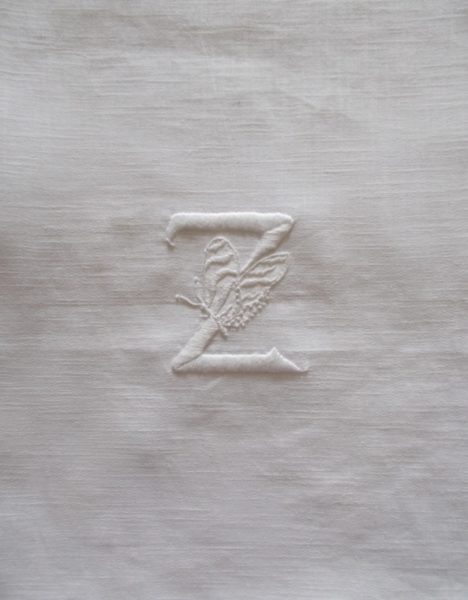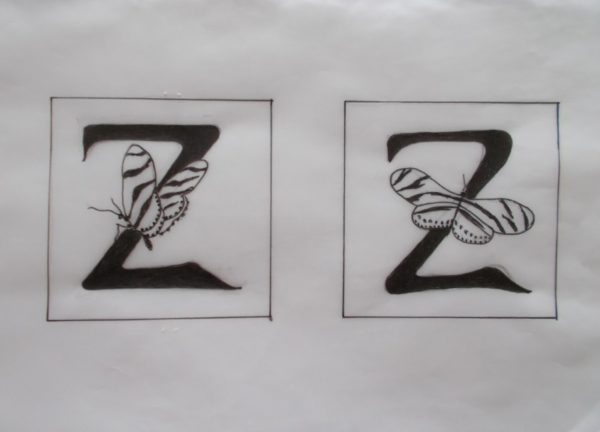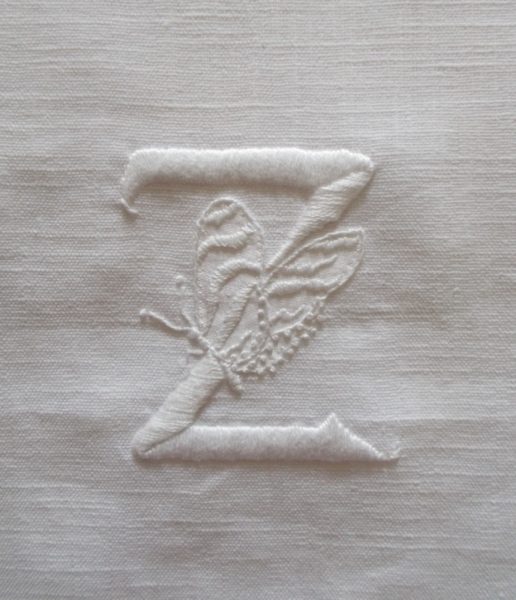
Z is for Zebra butterfly, , a whitework alphabet (hand embroidered by Mary Addison)
At the start of this embroidered alphabet project, I rather dismissed animals like the X-ray fish and the zebra butterfly for being second rate representatives for the initial letters of their names and for revealing a too great use of the imagination on the part of those given to the naming of animals. I even wondered whether such creatures had been named solely for the convenience of adding a bit of padding to those final difficult letters of the alphabet and thus making things easier for illustrators of children’s alphabets and people like myself who dabble in that sort of thing. This has not proved to be the case. It didn’t take much research to discover that these animals are fascinating not only for themselves but also because of the way their biology or their behaviour reverberates on that of our own species. As Linnaeus was the first to describe the zebra butterfly, I think I’ll just draw a veil over my sloppy thoughts and vow in future to avoid superficial judgments on areas I know nothing about.
Heliconius charithonia, the zebra butterfly is also commonly known as zebra longwing, which name reflects its unusually long wingspan (from 70 – 100mm / a little under 3″ – 4″ ) – perhaps even just a bit too long aesthetically although it is still markedly graceful in flight. No butterfly in the wild in England even vaguely approaches this size, so my family and I are fortunate to have seen them alive in a temporary exhibition of butterflies in the grounds of the Natural History Museum 2 or 3 years ago. The caterpillars are white with black spots and long black spikes, while the adult butterfly is dramatically patterned with white stripes on a dark background and white spots like seed pearls along and just in from the edge of the wings. (All a bit difficult to read on a whitework butterfly!) Their natural home is in Central America, extending as far north as southern Texas and peninsular Florida, with migrations even further north in warmer months. In 1996 the zebra butterfly became Florida’s official butterfly.

Z is for Zebra butterfly, , a whitework alphabet (hand embroidered by Mary Addison)
Zebras are greedy butterflies. They take not only nectar from plants but pollen too, which is rare in butterflies and results in a protein rich diet that has a dramatic effect, increasing the butterfly’s life span and producing more eggs. Most butterflies live for 2-4 weeks but a zebra can live up to 3 months in the wild and 4-5 months in the laboratory (the Natural History Museum, London, website suggests even up to 6 months). Pollen is digested internally by dissolving the grains in saliva. Because of their diets, both zebra butterflies and their caterpillars are aposematic which means they are poisonous and have the sort of dramatic colouration that warns off predators (just like PDFs, as the poison dart frogs are confusingly called by the small person). Caterpillars get their toxins from eating the leaves of passionflowers while the adults synthesise poison from pollen (when pollen is low, they have the ability to recycle previously synthesised products).
The butterflies may be poison to predators but within their species they are unusually sociable, roosting in large groups where positioning is hierarchical. The oldest butterflies chose the best spots and then others snuggle round them. Staff curating the butterflies in the Sensational Butterflies Exhibition at London’s Natural History Museum saw up to 30 ‘cosying’ up in the early evening. In the morning, they also noticed how older members of the group seem to nudge the younger ones out of bed. What a thought – teenagers’ need for morning sleep-ins may not be confined to Homo sapiens!

Z is for Zebra butterfly, , a whitework alphabet (hand embroidered by Mary Addison)
Before I opted for zebra butterflies I nearly chose zebra fish, picturing two little fish swimming in opposite directions in the zig zags of the Z like two little zodiacal pisces. Now I read (The Time 28 May 2020) that zebra fish have been making scientific headlines. Apparently and somewhat surprisingly, their neurons interact in a way similar to ours and as they are also transparent (and thus confusingly similar to X-ray fish) their behaviour and their brain activity can be studied without killing them. From the study on the fish, experiments were repeated using cultured human cells and from there it was shown that chemicals in the exhaust fumes of diesel powered vehicles can cause a build up of a protein in the brain such as is commonly seen in sufferers from Parkinson’s disease. Previous studies suggested the link but this research has shown how it happens. The zebra fish may come last in the alphabet but it is up at the front in scientific research.

8 Comments
Good morning, Mary! Just read this latest entry to Miss Georgia, who was rapt. I think your alphabet “book” is our favourite by far – it’s certainly the most interesting for Mum to read aloud! I’m learning so much, and of course, your embroidery is stunning.
We’ve a lovely cool morning here – the temperature is a cool 15C, half of what it was a couple of days ago. I’m happy to be wearing a sweater and socks, and the baby’s in footie pyjamas. Such a treat to be cosy. Hope you’re having a good weekend!
Good afternoon to you Austen – you posted this just after noon our time. We have rain, followed by brief dry interludes and then rain again. Not warm, but not cold either and windy. Very English. But weather only bothers me when it’s unremittingly wet day after day and it’s not like that now. As long as I have some sort of needle in hand, I’m having a good time.
Enjoy reading things out loud to Miss Georgia while you can – it’s not for long that you can trundle through Dante’s Inferno without them rumbling this is for you and not for them! The worst of it is they usually get to adore the picture book with the very poorest of texts – make sure you have Julia Donaldson high up on Georgia’s pile of children’s books and in no time at all you’ll enjoy chanting the text together ( We love, love, love ‘Room on the Broom’, ‘The Snail and the Whale’ and ‘Tiddler’, though personally I’m not so keen on ‘The Gruffallo’. But I’m sure you know these already.).
I’m now going to have a mental picture of a frog every time someone mentions a PDF to me, and I’m sure I’ll spread confusion one day!
Me too.
Just like PPE which to me is Politics, Philosophy and Economics which I spend 3 years studying at Oxford.
Imagine seeing 30 of these nesting together! Love your all white version of a black and white butterfly – and yet it is so clearly zebra striped!
ceci
Glad you can see the zebraness of the butterfly – thank you Ceci.
30 cuddled together would be pretty impressive!
We have really loved going to the butterfly exhibits here in Utah and another time on Key West. I am wondering if the butterfly you describe here is the same one we saw commonly around the landscape plantings in the house we rented in Nicaragua one summer. Off to Google pictures! Thank you for posting.
Nicaragua is very definitely Central America, so you’re v. probably right and with those slightly oddly long wings you should know when you see pictures. We loved the blue Morpho butterflies which are so extraordinarily big and have that wonderful iridescence to the blue on top of the wings. Little butterflies are a joy to see too but the big ones are quite something else.